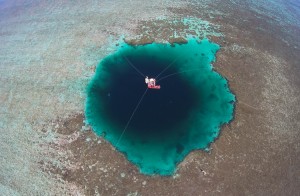The Deep Deep Dragon Hole
Friday, September 30th, 2016September 30, 2016
Chinese researchers have learned that a fabled ocean depth known as the Dragon Hole, a huge underwater chasm located in the South China Sea, is the deepest such natural feature in the world. For most of the past year, researchers made risky dives and used sonar scanners and underwater robots and cameras to explore the hole’s murky depths. They eventually found the Dragon Hole to be 987 feet (300 meters) deep. This makes it the deepest blue hole, a kind of vertical underwater cave, in the world’s oceans. The Dragon Hole (also known as the Sansha Yongle Blue Hole) is about 300 feet (100 meters) deeper than the second deepest such feature, known as Dean’s Blue Hole, located near the Bahamas in the Atlantic Ocean. The Dragon Hole lies among the Paracel Islands (also known as the Xisha Islands), about 175 miles (280 kilometers) southeast of China’s Hainan Island.

On July 24, 2016, a research vessel explores the Dragon Hole among the Paracel Islands in the South China Sea. Also known as the Sansha Yongle Blue Hole, it is the world’s deepest such underwater feature. Credit: © Luo Yunfei, VCG/Getty Images
A blue hole is a type of sinkhole, a bowl-shaped depression in Earth’s surface that forms where the ground sinks, collapses, or washes into underground openings. Such features often occur on dry land, where mildly acidic ground water dissolves underground rock. These openings most often develop in a rock called limestone, but sinkholes also form in other easily dissolved rocks. Blue holes form in rock formations that occur underwater. Over long periods, the rock making up the ocean floor can dissolve in the subsurface to form caves or cavities. If the rock forming the cave ceiling collapses, the newly formed hole on the seafloor is immediately filled with water.
Blue holes get their name from their distinctive deep blue color, a sharp contrast to surrounding, shallower, aquamarine waters. Blue holes can be dangerous for divers to explore because below about 300 feet (100 meters), there is virtually no oxygen and very little light. The steep walls of a blue hole extend into the dark depths, and it is often difficult to determine how far down the bottom lies. Blue holes can also host curious life forms, as the researchers of the Dragon Hole learned firsthand. They found 20 fish species that may be new to science.
Local people have known about the Dragon Hole for centuries. It clearly stands out on the ocean’s surface. The Dragon Hole is mentioned in the 1500′s Chinese mythical novel, Journey to the West. Often called Monkey in the West, the novel describes a pilgrimage of a Buddhist monk in the A.D. 600’s. In this story, a character called the Monkey King visits the Dragon Hole, an undersea kingdom ruled by a dragon.


